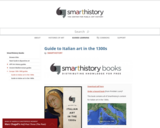
This book contains all of Smarthistory’s content for Italian art in the 1300s.
- Subject:
- Art History
- Arts and Humanities
- Visual Arts
- Material Type:
- Reading
- Provider:
- Smarthistory
- Author:
- SmartHistory
- Date Added:
- 11/18/2021
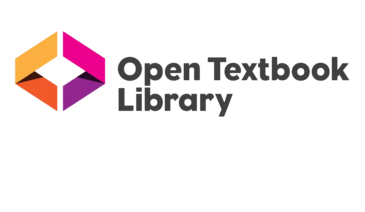
Browse OER Textbooks from the University of Minnesota's Open Textbook Library. These textbooks are authored and peer reviewed by faculty or other accredited subject matter experts. Many of these textbooks are actively used to teach OER based courses at instiutions across the United States.

This book contains all of Smarthistory’s content for Italian art in the 1300s.
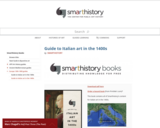
This book contains all of Smarthistory’s content for Italian art in the 1400s.

Qualitative and Quantitative Approaches
Word Count: 137942
(Note: This resource's metadata has been created automatically by reformatting and/or combining the information that the author initially provided as part of a bulk import process.)
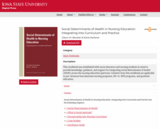
This workbook was established with nurse educators and nursing students in mind to provide knowledge, guidance, and support for integrating social determinants of health (SDOH) across the nursing education spectrum. Contents from this workbook are applicable to pre-licensure baccalaureate nursing programs, RN-to-BSN programs, and graduate education.
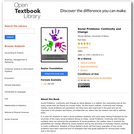
Social Problems: Continuity and Change by Steve Barkan is a realistic but motivating look at the many issues that are facing our society today. As this book’s subtitle, Continuity and Change, implies, social problems are persistent, but they have also improved in the past and can be improved in the present and future, provided that our nation has the wisdom and will to address them.
It is easy for students to read a social problems textbook and come away feeling frustrated by the enormity of the many social problems facing us today. Social Problems: Continuity and Change certainly does not minimize the persistence of social problems, but neither does it overlook the possibilities for change offered by social research and by the activities of everyday citizens working to make a difference. Readers of Steve Barkan’s book will find many examples of how social problems have been improved and of strategies that hold great potential for solving them today and in the future.
You will find several pedagogical features help to convey the “continuity and change” theme of this text and the service sociology vision in which it is grounded: Each chapter begins with a “Social Problems in the News” story related to the social problem discussed in that chapter. These stories provide an interesting starting point for the chapter’s discussion and show its relevance for real-life issues. Three types of boxes in each chapter provide examples of how social problems have been changed and can be changed.
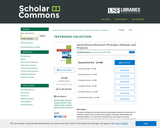
This book is designed to introduce doctoral and graduate students to the process of scientific research in the social sciences, business, education, public health, and related disciplines. This book is based on my lecture materials developed over a decade of teaching the doctoral-level class on Research Methods at the University of South Florida. The target audience for this book includes Ph.D. and graduate students, junior researchers, and professors teaching courses on research methods, although senior researchers can also use this book as a handy and compact reference.
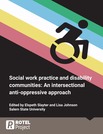
Given the high prevalence of disability worldwide, the status of disabled people remains an area of concern for practitioners who seek to respectfully engage with a stigmatized and often oppressed population. The book encourages practitioners to draw on intersectionality theory, the critical cultural competence framework and anti-oppressive practice approaches to contend with the concerns facing disabled people today. These issues include parenting, mass incarceration, ableism, aging and employment, among others. This title acknowledges difference and multisystemic privilege and oppression while also drawing readers’ attention to the importance of solidarity and allyship when it comes to meaningful social work practice with and social change for disabled people.
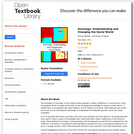
The founders of sociology in the United States wanted to make a difference. A central aim of the sociologists of the Chicago school was to use sociological knowledge to achieve social reform. A related aim of sociologists like Jane Addams, W.E.B. DuBois, and Ida B. Wells-Barnett and others since was to use sociological knowledge to understand and alleviate gender, racial, and class inequality.
Steve Barkan’s Sociology: Understanding and Changing the Social World makes sociology relevant for today’s students by balancing traditional coverage with a fresh approach that takes them back to sociology’s American roots in the use of sociological knowledge for social reform.
Print on demand edition available here: https://www.uncpress.org/book/9781469659282/sociology/
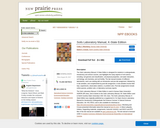
The Soils Laboratory Manual, K-State Edition is designed for students in undergraduate, introductory soil science courses, and highlights the many aspects of soil science, including: soil genesis and classification, soil physical properties, soil-water interaction, soil biology, soil chemistry, and soil fertility. The lab manual includes 15 different laboratories, each one starting with an introduction and pre-lab assignment, followed by in-lab activities, and complimented by post-lab assignment. In-lab activities involve field trips, experiments, observation stations, or problem sets. Post-lab assignments include online quizzes, problem sets, or laboratory summary reports.
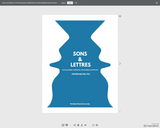
Sons et lettres provides a set of classroom materials to train students to hear and produce the sounds of French and to recognize the regular spellings used to represent those sounds in print. The materials are inspired by a desire to help students feel more confident about their French pronunciation and more at home saying the many French words, familiar and unfamiliar, which they encounter in their studies, in French media and in their travels. In our experience, students are not given sufficient preparation to successfully decipher and pronounce French words. These materials are intended to fill that gap and to clear away the confusion that English speakers often feel when they see French words with seemingly mysterious combinations of letters.

At its most basic definition the practice of law comprises conducting research to find relevant rules of law and then applying those rules to the specific set of circumstances faced by a client. However, in American law, the legal rules to be applied derive from myriad sources, complicating the process and making legal research different from other sorts of research. This text introduces first-year law students to the new kind of research required to study and to practice law. It seeks to demystify the art of legal research by following a “Source and Process” approach. First, the text introduces students to the major sources of American law and describes the forms the various authorities traditionally took in print. After establishing this base, the text proceeds to instruct students on the methods they will most likely use in practice, namely electronic research techniques and the consultation of secondary sources. Sources of Law incorporates screencasts currently hosted on YouTube that actively demonstrate the processes described in the static text. Finally, the text illustrates how the different pieces come together in the legal research process.
Sources of Law focuses on realistic goals for 1Ls to learn in a relatively small amount of instruction time, and so focuses mainly on the basics. It does introduce some advanced material so that 1Ls can recognize pieces of information they may encounter in research, but it does not fully cover researching materials outside the scope of the traditional 1L course. As such, it is best-suited for introductory legal research courses for 1Ls.

At its most basic definition the practice of law comprises conducting research to find relevant rules of law and then applying those rules to the specific set of circumstances faced by a client. However, in American law, the legal rules to be applied derive from myriad sources, complicating the process and making legal research different from other sorts of research. This text introduces first-year law students to the new kind of research required to study and to practice law. It seeks to demystify the art of legal research by following a “Source and Process” approach. First, the text introduces students to the major sources of American law and describes the forms the various authorities traditionally took in print. After establishing this base, the text proceeds to instruct students on the methods they will most likely use in practice, namely electronic research techniques and the consultation of secondary sources. Sources of Law incorporates screencasts currently hosted on YouTube that actively demonstrate the processes described in the static text. Finally, the text illustrates how the different pieces come together in the legal research process. Sources of Law focuses on realistic goals for 1Ls to learn in a relatively small amount of instruction time, and so focuses mainly on the basics. It does introduce some advanced material so that 1Ls can recognize pieces of information they may encounter in research, but it does not fully cover researching materials outside the scope of the traditional 1L course. As such, it is best-suited for introductory legal research courses for 1Ls. What's New in the Eighth Edition: The Eighth Edition primarily expands Chapter 9’s discussion of the research process to compare currently available legal generative AI tools to previously existing research tools such as secondary sources and electronic citators. That expansion also addresses some of the AI tools’ limitations and further discusses how thoughtful evaluation of available research tools can affect the research process.

An open educational text written by McBride.
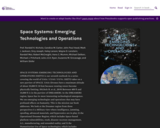
Short Description:
SPACE SYSTEMS: EMERGING TECHNOLOGIES AND OPERATIONS (SSETO) is our seventh textbook in a series covering the world of UASs / CUAS / UUVs. SSETO takes on a new purview of SPACE. UASs (Drones) have a maximum altitude of about 33,000 ft (10 km) because rotating rotors become physically limiting. (Nichols R. et al., 2019) Between 400 ft and 33,000 ft is in the purview of DREAMERS. In the DREAMERS region, Space has its most interesting technological emergence. We see emerging technologies and operations that may have profound effects on humanity. This is the mission our book addresses. We look at the Dreamer region from three perspectives:1) a Military view where intelligence, jamming, spoofing, advanced materials, and hypersonics are in play; 2) the Operational Dreamer Region; which includes Space-based platform vulnerabilities, trash, disaster recovery management, A.I., manufacturing, and extended reality; and 3) the Humanitarian Use of Space technologies; which includes precision agriculture wildlife tracking, fire risk zone identification, and improving the global food supply and cattle management. State-of-the-Art research by a team of fifteen SMEs is incorporated into our book. We trust you will enjoy reading it as much as we have in its writing. There is hope for the future.
Long Description:
SPACE SYSTEMS: EMERGING TECHNOLOGIES AND OPERATIONS is our seventh textbook in a series covering the world of UASs / CUAS/ UUVs. Other textbooks in our series are Drone Delivery of CBNRECy – DEW Weapons: Emerging Threats of Mini-Weapons of Mass Destruction and Disruption (WMDD); Disruptive Technologies with applications in Airline, Marine, Defense Industries; Unmanned Vehicle Systems & Operations On Air, Sea, Land; Counter Unmanned Aircraft Systems Technologies and Operations; Unmanned Aircraft Systems in the Cyber Domain: Protecting USA’s Advanced Air Assets, 2nd edition; and Unmanned Aircraft Systems (UAS) in the Cyber Domain Protecting USA’s Advanced Air Assets, 1st edition. Our previous six titles have received considerable global recognition in the field. (Nichols & Carter, 2022) (Nichols et al., 2021) (Nichols R. K. et al., 2020) (Nichols R. et al., 2020) (Nichols R. et al., 2019) (Nichols R. K., 2018)
Our seventh title takes on a new purview of Space. Let’s think of Space as divided into four regions. These are Planets, solar systems, the great dark void (which fall into the purview of astronomers and astrophysics), and the Dreamer Region. The earth, from a measurement standpoint, is the baseline of Space. It is the purview of geographers, engineers, scientists, politicians, and romantics. Flying high above the earth are Satellites. Military and commercial organizations govern their purview. The lowest altitude at which air resistance is low enough to permit a single complete, unpowered orbit is approximately 80 miles (125 km) above the earth’s surface. Normal Low Earth Orbit (LEO) satellite launches range between 99 miles (160 km) to 155 miles (250 km). Satellites in higher orbits experience less drag and can remain in Space longer in service. Geosynchronous orbit is around 22,000 miles (35,000 km). However, orbits can be even higher. UASs (Drones) have a maximum altitude of about 33,000 ft (10 km) because rotating rotors become physically limiting. (Nichols R. et al., 2019) Recreational drones fly at or below 400 ft in controlled airspace (Class B, C, D, E) and are permitted with prior authorization by using a LAANC or DroneZone. Recreational drones are permitted to fly at or below 400 ft in Class G (uncontrolled) airspace. (FAA, 2022) However, between 400 ft and 33,000 ft is in the purview of DREAMERS.
In the DREAMERS region, Space has its most interesting technological emergence. We see emerging technologies and operations that may have profound effects on humanity. This is the mission our book addresses. We look at the Dreamer Region from three perspectives:1) a Military view where intelligence, jamming, spoofing, advanced materials, and hypersonics are in play; 2) the Operational Dreamer Region; which includes Space-based platform vulnerabilities, trash, disaster recovery management, A.I., manufacturing, and extended reality; and 3) the Humanitarian Use of Space technologies; which includes precision agriculture wildlife tracking, fire risk zone identification, and improving the global food supply and cattle management.
Here’s our book’s breakdown:
SECTION 1 C4ISR and Emerging Space Technologies. C4ISR stands for Command, Control, Communications, Computers, Intelligence, Surveillance, and Reconnaissance. Four chapters address the military: Current State of Space Operations; Satellite Killers and Hypersonic Drones; Space Electronic Warfare, Jamming, Spoofing, and ECD; and the challenges of Manufacturing in Space.
SECTION 2: Space Challenges and Operations covers in five chapters a wide purview of challenges that result from operations in Space, such as Exploration of Key Infrastructure Vulnerabilities from Space-Based Platforms; Trash Collection and Tracking in Space; Leveraging Space for Disaster Risk Reduction and Management; Bio-threats to Agriculture and Solutions From Space; and rounding out the lineup is a chapter on Modelling, Simulation, and Extended Reality.
SECTION 3: Humanitarian Use of Space Technologies is our DREAMERS section. It introduces effective use of Drones and Precision Agriculture; and Civilian Use of Space for Environmental, Wildlife Tracking, and Fire Risk Zone Identification.
SECTION 3 is our Hope for Humanity and Positive Global Change. Just think if the technologies we discuss, when put into responsible hands, could increase food production by 1-2%. How many more millions of families could have food on their tables?
State-of-the-Art research by a team of fifteen SMEs is incorporated into our book. We trust you will enjoy reading it as much as we have in its writing. There is hope for the future.
Word Count: 111490
ISBN: 978-1-944548-48-3
(Note: This resource's metadata has been created automatically by reformatting and/or combining the information that the author initially provided as part of a bulk import process.)
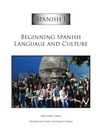
This peer-reviewed textbook is designed for the true beginner with U.S. college students in mind. It contains themed chapters, which are divided into 8 sections. Each section has its own set of learning objectives, and is further separated into three types of assignments, Para estudiar en casa (with detailed explanations), Para practicar en casa (homework exercises), and Para practicar en clase (paired and group classwork activities). The explanations and primary input are written to be easily comprehensible. The individual exercises are geared towards acquisition of form and function, and the communicative classwork exercises promote interpersonal exchanges between students. The digital copy includes some embedded audio files, and we are developing a website to house many more resources.
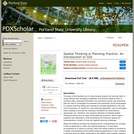
The goals of this textbook are to help students acquire the technical skills of using software and managing a database, and develop research skills of collecting data, analyzing information and presenting results. We emphasize that the need to investigate the potential and practicality of GIS technologies in a typical planning setting and evaluate its possible applications. GIS may not be necessary (or useful) for every planning application, and we anticipate these readings to provide the necessary foundation for discerning its appropriate use. Therefore, this textbook attempts to facilitate spatial thinking focusing more on open-ended planning questions, which require judgment and exploration, while developing the analytical capacity for understanding a variety of local and regional planning challenges.
While this textbook provides the background for understanding the concepts in GIS as applicable to urban and regional planning, it is best when accompanied by a hands-on tutorial, which will enable readers to develop an in-depth understanding of the specific planning applications of GIS. Chapters in this text book are either composed by the editors using Creative Common materials, or linked to a book chapter scanned copy in the library reserve. In the end of each chapter, we also provided several discussion questions, together with contextual applications through some web links.

Short Description:
Speak Out, Call In: Public Speaking as Advocacy is a contemporary, interdisciplinary public speaking textbook that fuses rhetoric, critical/cultural studies, and performance to offer an up-to-date resource for students. With a focus on advocacy, this textbook invites students to consider public speaking as a political, purposeful form of information-sharing.
Word Count: 70824
(Note: This resource's metadata has been created automatically by reformatting and/or combining the information that the author initially provided as part of a bulk import process.)

Short Description:
The title of this book is Speaking of Culture and its purpose is to define culture and many other concepts associated with it. My hope is that the readings in this book will help you to better understand the breadth of the concept of culture and provide you with a vocabulary for discussing it more articulately. Culture is one of those broad concepts that is used widely, although somewhat imprecisely, in everyday English. It also cuts across many academic disciplines, and this book draws on many of them. It touches, for instance, on anthropology, biology, history, mythology, political science, psychology, and sociology.
Long Description:
“Speaking of Culture” is a collection of instructor-authored background readings intended to accompany other activities, discussions, experiences, projects, and readings for IELI 2470 – Cross-Cultural Perspectives, a course offered by faculty in the Intensive English Language Institute at Utah State University. Its main purpose is to define culture and other concepts often associated with it.
Word Count: 46356
(Note: This resource's metadata has been created automatically by reformatting and/or combining the information that the author initially provided as part of a bulk import process.)

Spec is the default UI framework for Pharo. To build UI’s in Spec existing widgets or even complete UI’s are reused and configured to form a new UI.
This book first shows the basics of Spec and how it enables reuse of UIs. It then treats UI layout in detail before moving on to explaining the management of windows. Some of the more advanced widgets are also discussed as well as the dynamic features of Spec. Lastly, the book also contains a chapter with tips and tricks.
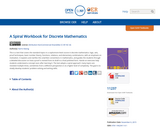
This is a text that covers the standard topics in a sophomore-level course in discrete mathematics: logic, sets, proof techniques, basic number theory, functions, relations, and elementary combinatorics, with an emphasis on motivation. It explains and clarifies the unwritten conventions in mathematics, and guides the students through a detailed discussion on how a proof is revised from its draft to a final polished form. Hands-on exercises help students understand a concept soon after learning it. The text adopts a spiral approach: many topics are revisited multiple times, sometimes from a different perspective or at a higher level of complexity. The goal is to slowly develop students’ problem-solving and writing skills.